Archive for July, 2022
» posted on Thursday, July 21st, 2022 by Linda Lou Burton
From the Queen Bee to the MMP
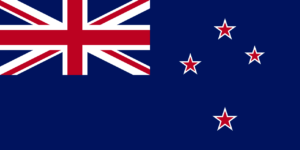 Originally Published July 23, 2020 by Linda Lou Burton posting about Wellington, New Zealand from Little Rock, Arkansas – This is a major election year in the United States, with politics running hot and uncertainty running high under the shadow of COVID-19. As I’ve studied the island nation of New Zealand these last few days, I found that 2020 is an election year there too – they do it every three years. So I dug in to see how it’s going.
Originally Published July 23, 2020 by Linda Lou Burton posting about Wellington, New Zealand from Little Rock, Arkansas – This is a major election year in the United States, with politics running hot and uncertainty running high under the shadow of COVID-19. As I’ve studied the island nation of New Zealand these last few days, I found that 2020 is an election year there too – they do it every three years. So I dug in to see how it’s going.
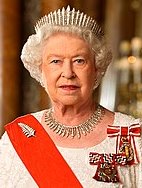 I learned that New Zealand ranks high in civic participation, with almost 80% voter turnout in recent elections. Considered one of the world’s most stable and well-governed states, the country is a constitutional monarchy with a parliamentary democracy, and Elizabeth II is the queen of New Zealand and therefore head of state.
I learned that New Zealand ranks high in civic participation, with almost 80% voter turnout in recent elections. Considered one of the world’s most stable and well-governed states, the country is a constitutional monarchy with a parliamentary democracy, and Elizabeth II is the queen of New Zealand and therefore head of state.
Now hang on and follow this trail, remember that the Beehive in Wellington is comparable to the US Capitol in Washington, DC. Here goes:
Head of State
As Head of State of New Zealand, the Queen has a range of royal powers which include signing bills into law, formally appointing governments and Ministers, appointing judges, and opening and dissolving Parliament.
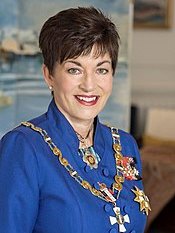 Her representative, the Governor-General, currently Dame Patsy Reddy (2016), has full authority to act on the Queen’s behalf when the Queen is not physically present in New Zealand. Make note: The Queen has visited New Zealand on only ten occasions since 1953, the last in 2002.The Constitution Act states that the Queen, or the Governor-General, can only exercise any of the royal powers with the advice and consent of the Government of the New Zealand.
Her representative, the Governor-General, currently Dame Patsy Reddy (2016), has full authority to act on the Queen’s behalf when the Queen is not physically present in New Zealand. Make note: The Queen has visited New Zealand on only ten occasions since 1953, the last in 2002.The Constitution Act states that the Queen, or the Governor-General, can only exercise any of the royal powers with the advice and consent of the Government of the New Zealand.
Head of Government
The New Zealand Government is the central government through which governing authority operates, within the framework “the Queen reigns, but the government rules, so long as it has the support of the House of Representatives.”
Parliament consists of the Sovereign, (the Head of State) and the House of Representatives, (the elected legislature.) Parliament has 120 seats.
 The Prime Minister is New Zealand’s head of government, with the authority to lead the government while answering to Parliament. The Prime Minister is formally appointed by the Governor General, based on agreements between parties and internal leadership votes. Jacinda Ardern (2017) serves as the current Prime Minister, an elected member of the Labour Party – the largest party in the coalition Government formed after the 2017 elections.
The Prime Minister is New Zealand’s head of government, with the authority to lead the government while answering to Parliament. The Prime Minister is formally appointed by the Governor General, based on agreements between parties and internal leadership votes. Jacinda Ardern (2017) serves as the current Prime Minister, an elected member of the Labour Party – the largest party in the coalition Government formed after the 2017 elections.
Political Parties in New Zealand
There are five parliamentary parties in the 52nd Parliament.
- The ACT Party has one member of Parliament. Read more
- The Green Party of Aotearoa / New Zealand has 8 members of Parliament, all from the party list. Read more
- The New Zealand Labour Party has 46 members of Parliament, 17 elected from the party list and 29 electorate seats. Read more
- The New Zealand National Party has 54 members of Parliament, 15 elected from the party list and 39 electorate seats. The National Party is in Opposition. Read more
- The New Zealand First Party has 9 members of Parliament, all from the party list. Read more
The MMP
MMP is the voting system in New Zealand. It stands for Mixed Member Proportional. A registered voter gets two votes under MMP:
- A party vote for a political party to help choose how many seats in Parliament each party gets.
- An electorate vote for a candidate from the area the voter lives in.
 Every candidate who wins an electorate gets a seat in Parliament. They are called Electorate MPs. The remaining seats are filled from party lists. Every party has a list of candidates ranked in the order the party wants those candidates to be elected to Parliament. Candidates elected from a party list are called List MPs.
Every candidate who wins an electorate gets a seat in Parliament. They are called Electorate MPs. The remaining seats are filled from party lists. Every party has a list of candidates ranked in the order the party wants those candidates to be elected to Parliament. Candidates elected from a party list are called List MPs.
Usually no party gets enough votes to govern alone. Parties often need to come to an agreement with other parties to form a government or pass legislation. Some types of possible agreements are:
- coalitions — when two or more parties join together to form a government
- confidence and supply agreements — when one party agrees to support another on certain issues and laws that are voted on in Parliament.
Who Can Vote
You are eligible to enroll and vote if you are 18 years or older, a New Zealand citizen or permanent resident, and you’ve lived in New Zealand continuously for 12 months or more at some time in your life. If you’re of Māori descent and enrolling for the first time, you may enroll on the general roll or the Māori roll to choose which electorate you vote in.
If you’re in New Zealand, you’ll be able to vote from Saturday 5 September to 7pm on election day, Saturday 19 September. Voting places will open across New Zealand, so everyone has a chance to vote. You can vote from overseas from Wednesday 2 September.
At the 2020 General Election, you can vote for the parties and candidates you want to represent you in Parliament, and you can vote in two referendums: whether the recreational use of cannabis should become legal, and whether the End of Life Choice Act 2019 should come into force, giving people with a terminal illness the option of requesting assisted dying.
Making It Safe To Vote
Keeping everyone safe is essential. Voting will open 2 days earlier than usual, and there will be more voting places to reduce queues. Vote locally and bring your own pen if you can. Hand sanitizer will be provided at voting places, and there will be space for physical distancing. If you need to stay home, you’ll have other ways of voting including voting by post.
Preliminary election results will be released from 7pm on 19 September; official results for the general election and referendums will be released on Friday 9 October.
This information was taken from the following websites, an impressive and useful array of tools to keep New Zealanders informed:
- The Beehive, Official website of the New Zealand Government, https://www.beehive.govt.nz/
- New Zealand Parliament, business, calendar, electorates, visit and learn, https://www.parliament.nz/
- Political Parties in New Zealand, https://www.parliament.nz/en/mps-and-electorates/political-parties/
- New Zealand Government, the system, how it works, how to engage, https://www.govt.nz/
- New Zealand Electoral Commission, complete voting information with a special page devoted to COVID-19 concerns: https://vote.nz/
» posted on Wednesday, July 20th, 2022 by Linda Lou Burton
Beehive & Five
Originally Published July 22, 2020 by Linda Lou Burton posting about Wellington, New Zealand from Little Rock, Arkansas – Here’s what I’d choose to do on my second full day in Wellington, after the bus tour overview and the birds-eye view from the helicopter. Wherever I go, I try to see things I couldn’t see anywhere else in the world. I’d like to see everything, but time and a creaky knee keep me reasonable. So I pick and choose the “most uniquest!”
Parliament and The Beehive
The “capitol building of the country” is always top of my list, and here, that is Parliament House, with its supporting building, the Beehive.
Parliament House, in use since 1918, is Edwardian neoclassical in style, a distinguished building that features New Zealand materials such as Takaka marble; marble columns line the front. The building contains the debating  chamber, speaker’s office, and committee rooms. It is open to visitors most days, though access to the public galleries above the debating chamber are possible only when the house is sitting; a dress code applies.
chamber, speaker’s office, and committee rooms. It is open to visitors most days, though access to the public galleries above the debating chamber are possible only when the house is sitting; a dress code applies.
The adjoining Beehive , completed in 1981, looks much like its clever name. Up top is the Cabinet room and the Prime Minister’s office; senior ministers are situated according to their ranking in Cabinet. Other facilities include function rooms, a banqueting hall, Pickwicks bar, Copperfields café, a theaterette used for press conferences, a gym, and a swimming pool! The country’s National Crisis Management Center is also located in this building. Guided tours available for both buildings; also educational visits for students.
https://www.parliament.nz/en/visit-and-learn/visit/
Te Papa
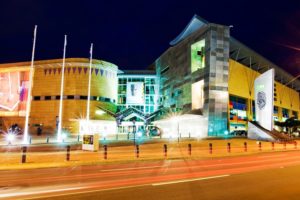 Wildly popular Te Papa is the national museum of New Zealand, six floors of cutting-edge interactive exhibits in an architectural wonder of a building. Its full name is Museum of New Zealand Te Papa Tongarewa, which translates to “container of treasures;” it is considered the home of New Zealand stories. Over 30 million people have come through since it opened in 1998; Trip Advisor rates it one of the top 25 museums in the world; Lonely Planet “one of the top 500 places on earth!” Te Papa’s clever, contemporary and bicultural approach puts it in a league of its own; the blend of artifacts and modern art powerfully shows how the nation’s heritage is so essential to modern-day culture. A good starting place is the Mana Whenua exhibit about New Zealand’s indigenous people, the Māori. The museum is open every day but Christmas and entry is free.
Wildly popular Te Papa is the national museum of New Zealand, six floors of cutting-edge interactive exhibits in an architectural wonder of a building. Its full name is Museum of New Zealand Te Papa Tongarewa, which translates to “container of treasures;” it is considered the home of New Zealand stories. Over 30 million people have come through since it opened in 1998; Trip Advisor rates it one of the top 25 museums in the world; Lonely Planet “one of the top 500 places on earth!” Te Papa’s clever, contemporary and bicultural approach puts it in a league of its own; the blend of artifacts and modern art powerfully shows how the nation’s heritage is so essential to modern-day culture. A good starting place is the Mana Whenua exhibit about New Zealand’s indigenous people, the Māori. The museum is open every day but Christmas and entry is free.
I would not miss this! https://www.tepapa.govt.nz/
Historic Red Cable Car
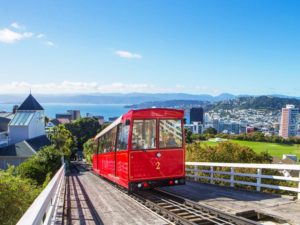 Never mind that the Red Cable Car is one of Wellington’s top tourist attractions; if I lived there I’d find a way to ride it at least once a week! Definitely an interesting way to get to work; imagine watching the seasons change from the seat of this charming vehicle, the cloud formations over the harbour, the sunset. A 5-minute ride leaving every 10-15 minutes from Lambton Quay, there is art too; murals at the terminal, active light installations in the tunnels, and a museum at the top. The Wellington Cable Car Museum is housed in the original winding house; two floors of exhibits tell the story of the cable car, in operation since 1902.
Never mind that the Red Cable Car is one of Wellington’s top tourist attractions; if I lived there I’d find a way to ride it at least once a week! Definitely an interesting way to get to work; imagine watching the seasons change from the seat of this charming vehicle, the cloud formations over the harbour, the sunset. A 5-minute ride leaving every 10-15 minutes from Lambton Quay, there is art too; murals at the terminal, active light installations in the tunnels, and a museum at the top. The Wellington Cable Car Museum is housed in the original winding house; two floors of exhibits tell the story of the cable car, in operation since 1902.
A must! https://www.wellingtoncablecar.co.nz/English/home.html
Zealandia
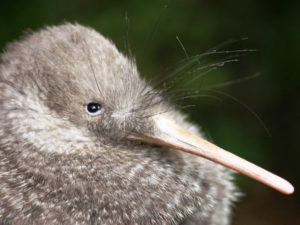 Zealandia is described as “a fully-fenced pest-proof urban island that is the closest thing you’ll find to being in New Zealand before humans arrived.” This pioneering eco-sanctuary just outside the city is an incredible slice of wilderness that turns back time on Wellington’s native environment. New Zealand was once an isolated land free from mammals, which meant native plants and birdlife flourished, including flightless kiwi. But with the arrival of humans came pests and predators, which caused the extinction of much wildlife and endangered many species. Two-hour tours with a guide; track down the rarest wildlife such as tuatara, prehistoric reptiles that have a real third eye, or giant weta that look like armored grasshoppers, or kererū, whose flapping wings sound like a helicopter! Night tours by torchlight might reveal glowworms, ruru owls, or the little spotted kiwi; end the evening with a cup of bushman’s tea.
Zealandia is described as “a fully-fenced pest-proof urban island that is the closest thing you’ll find to being in New Zealand before humans arrived.” This pioneering eco-sanctuary just outside the city is an incredible slice of wilderness that turns back time on Wellington’s native environment. New Zealand was once an isolated land free from mammals, which meant native plants and birdlife flourished, including flightless kiwi. But with the arrival of humans came pests and predators, which caused the extinction of much wildlife and endangered many species. Two-hour tours with a guide; track down the rarest wildlife such as tuatara, prehistoric reptiles that have a real third eye, or giant weta that look like armored grasshoppers, or kererū, whose flapping wings sound like a helicopter! Night tours by torchlight might reveal glowworms, ruru owls, or the little spotted kiwi; end the evening with a cup of bushman’s tea.
A definite visit here; ranks high on the Most Uniquest scale. https://www.visitzealandia.com/
WETA Workshop
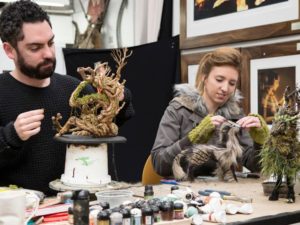 Wētā are giant flightless crickets, some of the heaviest insects in the world; something you’d see at Zealandia. The WETA Workshop is not about crickets though. It’s a design and manufacturing facility that turns out props, costumes, and creature effects for such Oscar-winning movies as Lord of the Rings and The Hobbit, also The Chronicles of Narnia, Avatar, Blade Runner 2049 to name a few. If you are among the millions of fans who love these movies, you’ve seen their work onscreen. I’m not, but I appreciate the craftsmanship and ingenuity it takes to make things that look so other-worldly and grand. Several tours, 45-minutes or full-day; watch people “just doing their work” in jobs that kids would die for.
Wētā are giant flightless crickets, some of the heaviest insects in the world; something you’d see at Zealandia. The WETA Workshop is not about crickets though. It’s a design and manufacturing facility that turns out props, costumes, and creature effects for such Oscar-winning movies as Lord of the Rings and The Hobbit, also The Chronicles of Narnia, Avatar, Blade Runner 2049 to name a few. If you are among the millions of fans who love these movies, you’ve seen their work onscreen. I’m not, but I appreciate the craftsmanship and ingenuity it takes to make things that look so other-worldly and grand. Several tours, 45-minutes or full-day; watch people “just doing their work” in jobs that kids would die for.
Unique, for sure! https://www.wetaworkshop.com/
Hannah’s Laneway and Cuba Street
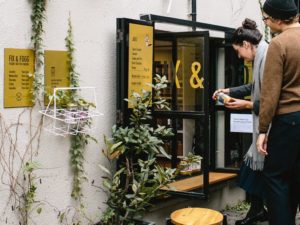 Hannah’s Laneway is Wellington’s little food haven. It’s right in the middle of town between Leeds and Eva Streets. Stop at the shop window of Fix & Fogg, for peanut butter tastings and gourmet toast, it takes its name from the classic Around the World in 80 Days characters Detective Fix and Phileas Fogg. Their peanut butter does go around the world – they ship to Australia, Singapore, the USA, beyond. Stroll on down the lane to Golding’s Free Dive (bar), Leeds Street Bakery, Wellington Chocolate Factory, Lashings (brownies!), Fortune Favours (brewbar), Shepherd (restaurant), Pizza Pomodoro, Hanging Ditch. Hanging Ditch is a cocktail bar where the range of liquor is, really, hanging – their bottles of booze are suspended from the ceiling, dangling overhead on bungee cords which the bartenders pull down to pour. Great selections of local beer and wine here too.
Hannah’s Laneway is Wellington’s little food haven. It’s right in the middle of town between Leeds and Eva Streets. Stop at the shop window of Fix & Fogg, for peanut butter tastings and gourmet toast, it takes its name from the classic Around the World in 80 Days characters Detective Fix and Phileas Fogg. Their peanut butter does go around the world – they ship to Australia, Singapore, the USA, beyond. Stroll on down the lane to Golding’s Free Dive (bar), Leeds Street Bakery, Wellington Chocolate Factory, Lashings (brownies!), Fortune Favours (brewbar), Shepherd (restaurant), Pizza Pomodoro, Hanging Ditch. Hanging Ditch is a cocktail bar where the range of liquor is, really, hanging – their bottles of booze are suspended from the ceiling, dangling overhead on bungee cords which the bartenders pull down to pour. Great selections of local beer and wine here too.
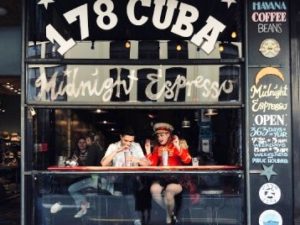 Cuba Street is Wellington’s most colorful street; get splashed by the famous Bucket Fountain (yes, buckets); discover quirky cafes, vintage clothing, record stores, art galleries. End the night at Midnight Espresso, one of the last places open late for midnight feasts; the café counter is piled high with vegetarian frittatas, pies, sandwiches, cakes and slices, flamboyantly decorated with fruits and flowers; the vast short-order menu is written large on the café wall; liquid refreshments are freshly squeezed juices and high-octane Havana espresso, of course.
Cuba Street is Wellington’s most colorful street; get splashed by the famous Bucket Fountain (yes, buckets); discover quirky cafes, vintage clothing, record stores, art galleries. End the night at Midnight Espresso, one of the last places open late for midnight feasts; the café counter is piled high with vegetarian frittatas, pies, sandwiches, cakes and slices, flamboyantly decorated with fruits and flowers; the vast short-order menu is written large on the café wall; liquid refreshments are freshly squeezed juices and high-octane Havana espresso, of course.
My kind of quirky unique! https://fixandfogg.com/usa and https://www.wellingtonnz.com/visit/cuba-street/
» posted on Tuesday, July 19th, 2022 by Linda Lou Burton
Kia ora
Originally Published July 22, 2020 by Linda Lou Burton posting about Wellington, New Zealand from Little Rock, Arkansas – Ha! It is raining in Little Rock this morning, a soft, gentle rain, no thunder, no downpour. Only 79 degrees, here in July! I take credit for such a gentle day, because I am mentally in  Wellington today (where I had PLANNED to be before COVID-19 struck the world and shut down travel anywhere). Mentally, I’m taking note of differences, and similarities, between Little Rock and Wellington. I’ve already mentioned they are about the same in number of people, but with different seasons in effect, time to be out and about today differs by nearly five hours. Little Rock’s summer daylight will last 14 hours. Wellington’s winter sunrise happens just before 8 this morning; sunset occurs just after 5.
Wellington today (where I had PLANNED to be before COVID-19 struck the world and shut down travel anywhere). Mentally, I’m taking note of differences, and similarities, between Little Rock and Wellington. I’ve already mentioned they are about the same in number of people, but with different seasons in effect, time to be out and about today differs by nearly five hours. Little Rock’s summer daylight will last 14 hours. Wellington’s winter sunrise happens just before 8 this morning; sunset occurs just after 5.
So, with not a minute to waste, I (would have) scheduled two tours in Wellington yesterday. A morning bus tour to get the highlights of the city up close. And an afternoon helicopter ride for a bird’s eye view of everything. That would mean that today I’m in the know about where I’d want to spend more time, and, a bonus, by listening to my guides, I’d have learned a very important word.
And that important word is Kia ora.
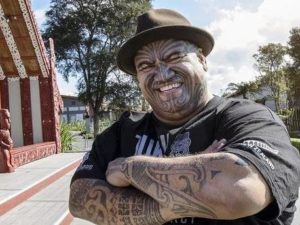 Kia ora is generally pronounced KEE-au-ra but however it sounds the point is Hi! or G’day! Interchangeable as a salutation, or farewell, or even an expression of thanks, the New Zealand Ministry for Culture and Heritage website lists it as one of 100 Māori words every New Zealander should know. Yes, it is from the Māori language; the word “ora” as a noun means “life, health, vitality.” It’s an attitude; a way of life. It’s an inclusive, uplifting expression, kind of an “air hug,” a verbal smile.
Kia ora is generally pronounced KEE-au-ra but however it sounds the point is Hi! or G’day! Interchangeable as a salutation, or farewell, or even an expression of thanks, the New Zealand Ministry for Culture and Heritage website lists it as one of 100 Māori words every New Zealander should know. Yes, it is from the Māori language; the word “ora” as a noun means “life, health, vitality.” It’s an attitude; a way of life. It’s an inclusive, uplifting expression, kind of an “air hug,” a verbal smile.
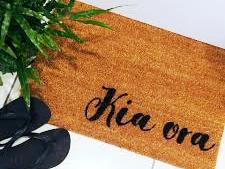 Kia ora, a beautiful word. You’ll hear it everywhere, and you’ll see it printed on everything from jewelry to doormats. It’s the name of Air New Zealand’s inflight magazine; and the greeting they sent me when they confirmed my reservation. And, when they had to cancel it.
Kia ora, a beautiful word. You’ll hear it everywhere, and you’ll see it printed on everything from jewelry to doormats. It’s the name of Air New Zealand’s inflight magazine; and the greeting they sent me when they confirmed my reservation. And, when they had to cancel it.
So I’m really in Little Rock today. But here’s what I would have done yesterday, if I could have.
Morning By Land
Hammonds Wellington Sightseeing Tours, https://wellingtonsightseeingtours.co.nz/
 Just my style, friendly and down-to-earth tour guides for back and forth chats. A tour bus with focus on accessibility so I can get off and on with ease. Stops at places of great interest to me: New Zealand’s Parliament Buildings and Beehive. Old Saint Paul’s Cathedral. Wellington Botanic Gardens . Wellington Cable Car. Mount Victoria.
Just my style, friendly and down-to-earth tour guides for back and forth chats. A tour bus with focus on accessibility so I can get off and on with ease. Stops at places of great interest to me: New Zealand’s Parliament Buildings and Beehive. Old Saint Paul’s Cathedral. Wellington Botanic Gardens . Wellington Cable Car. Mount Victoria.
Afternoon By Air
Wellington Helicopters, GCH Aviation, https://gchaviation.com/wellington-city-scenic/
 A daring do in a windy city, but what could be better that flying over downtown Wellington and the harbour from the luxury of an EC130 helicopter? Nine minutes and a birds-eye view of iconic buildings such as Te Papa, the Beehive and the Cake Tin. Magnificent!
A daring do in a windy city, but what could be better that flying over downtown Wellington and the harbour from the luxury of an EC130 helicopter? Nine minutes and a birds-eye view of iconic buildings such as Te Papa, the Beehive and the Cake Tin. Magnificent!
A nap after that, a fabulous dinner, a good night’s sleep. And then a day of focus, first stop, the Capital City stuff, like – the Beehive. That’s my next post, stay tuned.
Meanwhile, wherever you are and whatever your weather today, go to these websites that surely are the pride of New Zealand, so rich in information you won’t know where to stop.
Ministry for Culture and Heritage, Wellington https://mch.govt.nz/
- Dictionary of New Zealand Biography: The foremost reference work on the lives of people who shaped this country’s history. Dictionary of New Zealand Biography.
- Roadside Stories: More than 100 3-4 minute anecdotal tales about New Zealand’s history, places, people and events. Roadside Stories website.
- Te Ara — The Encyclopedia of New Zealand: Provides website resources about New Zealand’s people, land, culture and society. Te Ara — The Encyclopedia of New Zealand website.
- Tuia – Encounters 250: 250 years since the first onshore meetings between Māori and Europeans. Tuia 250 website
See y’all later, as we say in Little Rock. And from Wellington – Kia ora!
» posted on Monday, July 18th, 2022 by Linda Lou Burton
Wearing Your Wellies
 Originally Published July 21, 2020 by Linda Lou Burton posting about Wellington, New Zealand from Little Rock, Arkansas – Light rain in Wellington today, with a high of 52. I don’t mind the rain. I learned how to enjoy a misty day living in Seattle, it doesn’t even slow you down. I’m settled in one time zone and one season for now; so I imagine Wellingtonians walking in the rain today, water drops splatting as their boots come down. Is there anything more fun than splashing in a puddle? It’s irresistible, especially when you’re wearing your rubber-ducky yellow. Wellies in Wellington, time for a story.
Originally Published July 21, 2020 by Linda Lou Burton posting about Wellington, New Zealand from Little Rock, Arkansas – Light rain in Wellington today, with a high of 52. I don’t mind the rain. I learned how to enjoy a misty day living in Seattle, it doesn’t even slow you down. I’m settled in one time zone and one season for now; so I imagine Wellingtonians walking in the rain today, water drops splatting as their boots come down. Is there anything more fun than splashing in a puddle? It’s irresistible, especially when you’re wearing your rubber-ducky yellow. Wellies in Wellington, time for a story.
 The city of Wellington, New Zealand was named in honor of Arthur Wellesley, the first Duke of Wellington; a title that comes from the town of Wellington in England. Now, the Duke was a popular fellow, having won the Battle of Waterloo in 1815, and when the original settlers of the New Zealand Company sat down in 1840 to name their new colony, the Duke’s name popped to the top. He was a supporter of the principles of “colonization.”
The city of Wellington, New Zealand was named in honor of Arthur Wellesley, the first Duke of Wellington; a title that comes from the town of Wellington in England. Now, the Duke was a popular fellow, having won the Battle of Waterloo in 1815, and when the original settlers of the New Zealand Company sat down in 1840 to name their new colony, the Duke’s name popped to the top. He was a supporter of the principles of “colonization.”
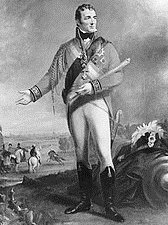 But let’s go back to England for a moment. The Duke wasn’t just a war hero, he was also a bit of a fashion plate. Now “Hessian boots” were quite dandy-looking, high-cut and tasseled, but one day the Duke asked his shoemaker to modify the design a little, removing the trim, and cutting it to fit more closely around the leg. A good riding boot, but smart enough for evening wear, the style began to be called “the Wellington.” This soft leather boot became the main fashion for men of the British aristocracy through the mid 1800s.
But let’s go back to England for a moment. The Duke wasn’t just a war hero, he was also a bit of a fashion plate. Now “Hessian boots” were quite dandy-looking, high-cut and tasseled, but one day the Duke asked his shoemaker to modify the design a little, removing the trim, and cutting it to fit more closely around the leg. A good riding boot, but smart enough for evening wear, the style began to be called “the Wellington.” This soft leather boot became the main fashion for men of the British aristocracy through the mid 1800s.
Then along came Charles Goodyear, and vulcanization, and rubber boots. And a bit of re-branding. A “wellington-type” boot made of rubber was the perfect choice for farmers! Or anybody who had to work outdoors in the muck and the mire.
 Now for one more twist. The Kauri tree grows in New Zealand, a tree that oozes a resin from its bark and cones. This resin, or gum, builds up in the forks of the tree, drops to the ground, and over time as the tree falls and dies the littered wood and gum eventually get buried by soil or drowned in swamps. The Māori – the indigenous Polynesian people of New Zealand – had many uses for this gum. They chewed it fresh from the trees; they used it to start fires and make torches.
Now for one more twist. The Kauri tree grows in New Zealand, a tree that oozes a resin from its bark and cones. This resin, or gum, builds up in the forks of the tree, drops to the ground, and over time as the tree falls and dies the littered wood and gum eventually get buried by soil or drowned in swamps. The Māori – the indigenous Polynesian people of New Zealand – had many uses for this gum. They chewed it fresh from the trees; they used it to start fires and make torches.
Enter the Europeans, who saw the commercial benefits of Kauri gum. In the early 1840s a consignment was sent to London to make fire-kindlers and marine glue. But its real value was as an ingredient in varnish, and an industry was born. Māori and European settlers began digging the stuff out of the ground. Swampy, muddy ground. Boots were a good thing to keep your feet dry, natch?
Wellies! Gum Boots!
 The farming town of Talihape in the North Island claims the title “Gumboot Capital of the World” and has annual competitions and events. Most gumboots are black, though certain professions call for white, but kids, of course, wear boots of many colors. Like rubber-ducky yellow.
The farming town of Talihape in the North Island claims the title “Gumboot Capital of the World” and has annual competitions and events. Most gumboots are black, though certain professions call for white, but kids, of course, wear boots of many colors. Like rubber-ducky yellow.
Next rainy day when you pull out your Wellies, aka Gumboots, remember the Duke, the Māori, and Charles Goodyear. What an incredible round-the-world connection.
History is a fascinating thing.
» posted on Sunday, July 17th, 2022 by Linda Lou Burton
Topsy Turvy
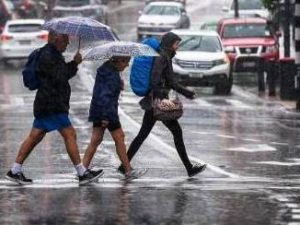 Originally Published July 20, 2020 by Linda Lou Burton posting about Wellington, New Zealand from Little Rock, Arkansas – I don’t know how the jet-setters do it. Crossing the International Dateline east to west on my now defunct RTW Capital City Quest, I’d lose an entire day. Crossing the Equator, I’d change hemispheres, and therefore, seasons. It may feel like 106 in Little Rock today, but it’s winter in Wellington! Though winter there isn’t too bad – 54 degrees with a breeze today; 100% chance of rain.
Originally Published July 20, 2020 by Linda Lou Burton posting about Wellington, New Zealand from Little Rock, Arkansas – I don’t know how the jet-setters do it. Crossing the International Dateline east to west on my now defunct RTW Capital City Quest, I’d lose an entire day. Crossing the Equator, I’d change hemispheres, and therefore, seasons. It may feel like 106 in Little Rock today, but it’s winter in Wellington! Though winter there isn’t too bad – 54 degrees with a breeze today; 100% chance of rain.
Pago Pago, American Samoa is the southernmost US capital city, but Wellington, New Zealand is the southernmost capital city in the entire world. It is also the most remote capital city, the farthest from any other capital. Now that’s a noteworthy distinction, and puts it at the top of my “Capital City Superlatives” list.
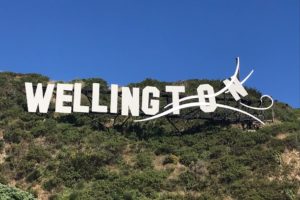 Here are some basics about Wellington: its urban land area is 171 sq miles, the metro area 536, with an elevation of 0 at the waterfront and 1,624 in the hills. It isn’t New Zealand’s largest city, population-wise, Auckland is. Wellington’s urban population is 215,400, with a metro population of 424,200. That’s comparable to the US capital cities of Little Rock, say, or Madison, Wisconsin. The population breakdown shows about 72% of Wellingtonians are of European ethnicity; 15% Asian, 14% Maori, 10% various Pacific peoples, and the remainder Middle Eastern, Latin, African, and other.
Here are some basics about Wellington: its urban land area is 171 sq miles, the metro area 536, with an elevation of 0 at the waterfront and 1,624 in the hills. It isn’t New Zealand’s largest city, population-wise, Auckland is. Wellington’s urban population is 215,400, with a metro population of 424,200. That’s comparable to the US capital cities of Little Rock, say, or Madison, Wisconsin. The population breakdown shows about 72% of Wellingtonians are of European ethnicity; 15% Asian, 14% Maori, 10% various Pacific peoples, and the remainder Middle Eastern, Latin, African, and other.
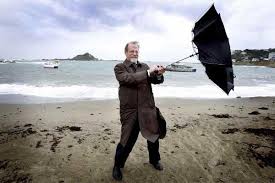 Wellington has been capital of New Zealand since 1865, and sits at the south end of the north island, between Cook Strait and the Remutaka Range. Because of its location in the Roaring Forties – strong westerly winds caused by air being displaced from the Equator towards the South Pole – it is considered the world’s windiest city, giving it the nickname Windy Welly.
Wellington has been capital of New Zealand since 1865, and sits at the south end of the north island, between Cook Strait and the Remutaka Range. Because of its location in the Roaring Forties – strong westerly winds caused by air being displaced from the Equator towards the South Pole – it is considered the world’s windiest city, giving it the nickname Windy Welly.
It has a few other catchy names too – in 2016 the Mercer Quality of Living Survey ranked Wellington 12th Most Livable City in the World; in 2018 Deutsche Bank ranked it first in the world for both livability and non-pollution (those winds help, I suppose!). And Lonely Planet dubbed it the Coolest Little Capital in the World, pretty snazzy, I’d say.
But why am I talking? Those who promote New Zealand for a living have the best websites I’ve ever seen, so let’s read up, no mask needed for that. Straight from the horse’s mouth, https://www.newzealand.com/us/wellington/ will guide you not only in Wellington, but over all of New Zealand, with focus on any city of your choice; https://www.wellingtonnz.com/ tells everything you’ll want to know about the capital city with gorgeous pictures and fast-paced videos.
Here are a few things I shamelessly lifted from their sites, hoping to promote the area, and wishing I were there.
Things To Do in Wellington
Surrounded by nature and fueled by creative energy, Wellington is a compact city with a powerful mix of culture, history, nature and cuisine. Fuel your visit with strong coffee and world-class craft beer – Wellingtonians are masters of casual dining, with plenty of great restaurants, night markets and food trucks.
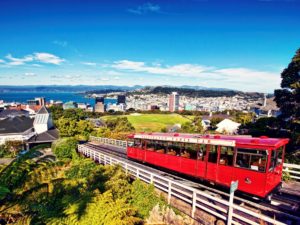 Relax at Oriental Bay, Wellington’s golden-sand inner-city beach and delve into the many museums, art galleries and theatre shows that make up the city’s pulsing cultural scene. If you’re into the outdoors, Wellington has action-packed adventure activities like mountain biking and sea-water kayaking, as well as beautiful walks around the harbour and surrounding hills. Ride the cable car up the hill to Kelburn for amazing views over the city. On the waterfront itself you’ll find New Zealand’s national museum, Te Papa, meaning ‘our place,’ one of the best interactive museums in the world.
Relax at Oriental Bay, Wellington’s golden-sand inner-city beach and delve into the many museums, art galleries and theatre shows that make up the city’s pulsing cultural scene. If you’re into the outdoors, Wellington has action-packed adventure activities like mountain biking and sea-water kayaking, as well as beautiful walks around the harbour and surrounding hills. Ride the cable car up the hill to Kelburn for amazing views over the city. On the waterfront itself you’ll find New Zealand’s national museum, Te Papa, meaning ‘our place,’ one of the best interactive museums in the world.
Or if you just want a quickie two-minute tour, watch this video!
https://www.youtube.com/watch?v=72stLrXYmHo
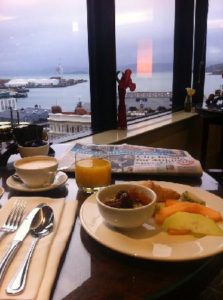 As for me and my make-believe COVID-19-free RTW journey, I got up at 7 AM on Saturday July 18, flew from Pago Pago to Apia to Auckland to Wellington in a sleepless mad rush of plane changes and time changes and weather changes and culture changes, and arrived at my hotel at 9 AM Wellington time on Monday July 20. In true jet-setter style, I’m booked in an executive suite at the Intercontinental, 14th floor, waterfront view, where I hunker down, gaze across the bay, and try to figure out which end is up.
As for me and my make-believe COVID-19-free RTW journey, I got up at 7 AM on Saturday July 18, flew from Pago Pago to Apia to Auckland to Wellington in a sleepless mad rush of plane changes and time changes and weather changes and culture changes, and arrived at my hotel at 9 AM Wellington time on Monday July 20. In true jet-setter style, I’m booked in an executive suite at the Intercontinental, 14th floor, waterfront view, where I hunker down, gaze across the bay, and try to figure out which end is up.
Tomorrow I’ll be right side up again.
» posted on Saturday, July 16th, 2022 by Linda Lou Burton
Time Flies
Originally Published July 19, 2020 by Linda Lou Burton posting about American Samoa from Little Rock, Arkansas – I was so terrified I’d miss the flight I called Talofa Airlines. I was booked with Air New Zealand to fly from Apia, Samoa to Auckland, then Wellington, for my stay in the southernmost capital city in the world. The WORLD! Air New Zealand would depart Apia at 9:45 PM on the 19th and fly me through the night; my Wellington hotel was booked beginning Monday, July 20.
That part was easy. But first, I had to get to Apia.
 Lots of inter-island flights via Talofa, no problem there. But I kept staring at the map and that International Dateline that separates Pago Pago and Apia. I simply could not wrap my mind around the concept of TIME.
Lots of inter-island flights via Talofa, no problem there. But I kept staring at the map and that International Dateline that separates Pago Pago and Apia. I simply could not wrap my mind around the concept of TIME.
“When do I need to leave Pago Pago to get to Apia in time to catch my July 19th flight?” I asked. “Do I need to check out of Sadie’s-By-The-Sea on the 18th or the 19th?”
She assured me that I must check out on the 18th. “So, I LEAVE Pago Pago on Saturday the 18th, fly west to Apia, and ARRIVE 30 minutes later on Sunday the 19th?” I repeated this phrase several times. “Are you SURE?”
She was sure.
Thanks to COVID-19, I will not get to experience how it feels to lose an entire day of one’s life while being perfectly behaved. So instead, on this hot Sunday afternoon in Little Rock (it is 96 feels like 106 at 1 PM) I will concentrate on “How I Would Spend My Time” on the beautiful, still virus-free, island of American Samoa, if I were really there, whatever day it was.
I’d focus on the two reasons I came: to see the National Park, and to experience the “capital city” aspects of our southernmost US capital. With a room right on the water at Sadie’s-By-The-Sea, I’d be feeling rested, and ready to go.
The National Park Visitor Center is just a mile from Sadie’s, the road follows the harbor; I’d have a rental car. I’d learn about the subsistence farming that is allowed on some parklands, it’s the Fa’a Samoa way; there are small plantations to see. I’d learn about the birds, as the park is  home to over 35 resident and migratory species – seabirds, water birds, forest birds, shorebirds; perhaps I’d spot a blue kingfisher (you know how I love birds!). I’d learn about the Pe’a (Fruit Bats), with wing spans up to 3-feet wide. These unusual bats are active both day and night and they only live here; also called the Flying Fox, one is featured on the 2020 American Samoa quarter! I’d learn about coral reefs, marine life, rainforests; things I don’t know much about and seldom get a chance to see. I’d learn about the customs and the history; the villages, the chiefs, the princesses. The celebrations, and the dance. That’s just the Park. https://www.nps.gov/npsa/index.htm
home to over 35 resident and migratory species – seabirds, water birds, forest birds, shorebirds; perhaps I’d spot a blue kingfisher (you know how I love birds!). I’d learn about the Pe’a (Fruit Bats), with wing spans up to 3-feet wide. These unusual bats are active both day and night and they only live here; also called the Flying Fox, one is featured on the 2020 American Samoa quarter! I’d learn about coral reefs, marine life, rainforests; things I don’t know much about and seldom get a chance to see. I’d learn about the customs and the history; the villages, the chiefs, the princesses. The celebrations, and the dance. That’s just the Park. https://www.nps.gov/npsa/index.htm
 Then I’d follow the map to find my way around town. Maybe I’d lunch at the famous Sadie Thompson Inn; or check out the Marketplace in Fagatogo Square, looking for traditional Samoan food like palusami (wrapped bundles of taro leaves with a coconut and onion filling, sometimes with chicken, fish, or corned beef).
Then I’d follow the map to find my way around town. Maybe I’d lunch at the famous Sadie Thompson Inn; or check out the Marketplace in Fagatogo Square, looking for traditional Samoan food like palusami (wrapped bundles of taro leaves with a coconut and onion filling, sometimes with chicken, fish, or corned beef).
 I’d stop at the Maota Fono complex, a bee-hive shaped building based on the traditional Samoan fale (oval or circular, domed, thatched roof held up by poles). The American Samoa territorial legislature (Fono) is housed here; there is a two-story main wing, with offices for the legislators and governor, flanked by two single-story wings housing the legislative chambers. The Fono is a bicameral legislature with a House of Representatives and a Senate, the only legislature in the US that is both bicameral and nonpartisan. (The Nebraska Legislature is nonpartisan but is a unicameral body.)
I’d stop at the Maota Fono complex, a bee-hive shaped building based on the traditional Samoan fale (oval or circular, domed, thatched roof held up by poles). The American Samoa territorial legislature (Fono) is housed here; there is a two-story main wing, with offices for the legislators and governor, flanked by two single-story wings housing the legislative chambers. The Fono is a bicameral legislature with a House of Representatives and a Senate, the only legislature in the US that is both bicameral and nonpartisan. (The Nebraska Legislature is nonpartisan but is a unicameral body.)
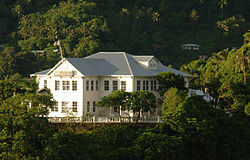 I’d stop at Government House, a colonial mansion atop Mauga o Ali’i (the chief’s hill). The building was erected in 1903 under orders of a US Naval Admiral; from here naval governors administered the territory until 1951. It now serves as the official residence of the territory’s governor and first lady, where they host major dignitaries who visit the island. There are five public rooms, one showcasing Samoan artifacts.
I’d stop at Government House, a colonial mansion atop Mauga o Ali’i (the chief’s hill). The building was erected in 1903 under orders of a US Naval Admiral; from here naval governors administered the territory until 1951. It now serves as the official residence of the territory’s governor and first lady, where they host major dignitaries who visit the island. There are five public rooms, one showcasing Samoan artifacts.
I’d stop at the Jean P Hayden Museum; in addition to Samoan artifacts, it has Moon Rocks due to American Samoa’s link to the Apollo Moon Missions. I’d stop at the Ocean Center at the National Marine Sanctuary, where one of the main exhibits is a room-sized global system displaying planetary data. https://americansamoa.noaa.gov/visit/
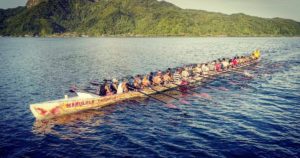 I’d drive out to Blunt’s Point to see the World War II Cannons, and stop at Utulei Beach and gaze across Pago Pago Harbor to Rainmaker Mountain on the other side. I’d do my best to wangle a ride in a fautasi, a long boat with 40 paddlers, and I’d shop for a puletasi – that’s a two-piece long fitted blouse and skirt.
I’d drive out to Blunt’s Point to see the World War II Cannons, and stop at Utulei Beach and gaze across Pago Pago Harbor to Rainmaker Mountain on the other side. I’d do my best to wangle a ride in a fautasi, a long boat with 40 paddlers, and I’d shop for a puletasi – that’s a two-piece long fitted blouse and skirt.
I’d talk with everyone who’d talk with me, making sure I always said SAH-mo-a when speaking, as it is pronounced there, and not Sa-MO-a, as I’ve always done.
Seems like I’d need to add a day, not lose one. Time flies.
 Governor: Lolo Matalasi Moliga
Governor: Lolo Matalasi Moliga
Proclamation issued July 1, 2020 in effect until July 30, 2020 regarding COVID-19 restrictions lists current status as Code Blue: minimal social disruption with emphasis on social distancing, hygiene, and cough etiquette.
Office of the Governor: https://www.americansamoa.gov/office-of-the-governor
» posted on Friday, July 15th, 2022 by Linda Lou Burton
One Samoa Two Samoa
Originally Published July 18, 2020 by Linda Lou Burton posting about the Samoan Islands from Little Rock, Arkansas – Divide the thousands of islands in the Pacific Ocean into three major cultural areas – Micronesia, Melanesia, and Polynesia. Now let’s hone in on one, the part of my planned RTW journey – Polynesia. What is Polynesia, anyhow? Geologically speaking, it is more than a thousand islands in the mid and southern part of the Pacific. Most Polynesian islands and archipelagos, including the Hawaiian and Samoan islands, are volcanic, built by hotspots (remember our Hot Spot post of July 15). But some are the unsubmerged portions of a largely sunken continent. New Zealand, the largest island in Polynesia, is one of those.
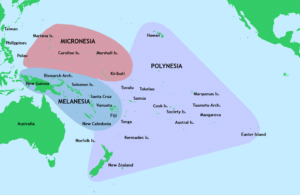 Culturally, these Polynesian islands share similarities in language and belief systems, and not surprisingly, a strong tradition of sailing. Politically, they differ widely. Within the core island groups, there are countries, collectivities, dependencies, self-governing states, a US state, four territories and four independent nations! My RTW was to include stops in the US state of Hawaii, the US territory of American Samoa, and the independent nations of Samoa, and New Zealand.
Culturally, these Polynesian islands share similarities in language and belief systems, and not surprisingly, a strong tradition of sailing. Politically, they differ widely. Within the core island groups, there are countries, collectivities, dependencies, self-governing states, a US state, four territories and four independent nations! My RTW was to include stops in the US state of Hawaii, the US territory of American Samoa, and the independent nations of Samoa, and New Zealand.
Today’s focus: American Samoa and Samoa
American Samoa
- Capital: Pago Pago
- Land Area: 77 sq miles
- Population: 55,212
- Currency: US Dollar
- Language: English, Samoan
- Religion: 98% Christian
- Airport: Pago Pago International, service to Honolulu, inter-island
Samoa
- Capital: Apia
- Land Area: 1,097 sq miles
- Population: 195,843
- Currency: Tala
- Language: Samoan, English
- Religion: Christian Official
- Airport: Faleolo International Airport, service to Australia, New Zealand, Honolulu, inter-island
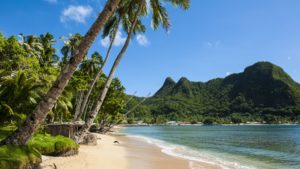 American Samoa, capital city Pago Pago, has been a US territory since 1900 and the end of the Second Samoan Civil War, when the Samoan Islands were divided. For 51 years the US Navy controlled the territory. Today American Samoa is locally self-governing under a 1967 constitution. In 1977 the first governor was elected; in 1981 the first non-voting member of Congress. People born in American Samoa are US nationals, but not citizens. It is the only US Territory where citizenship is not granted automatically at birth.
American Samoa, capital city Pago Pago, has been a US territory since 1900 and the end of the Second Samoan Civil War, when the Samoan Islands were divided. For 51 years the US Navy controlled the territory. Today American Samoa is locally self-governing under a 1967 constitution. In 1977 the first governor was elected; in 1981 the first non-voting member of Congress. People born in American Samoa are US nationals, but not citizens. It is the only US Territory where citizenship is not granted automatically at birth.
 Samoa, capital city Apia, is a unitary parliamentary democracy, and a member of the Commonwealth of Nations and the United Nations. It was governed by New Zealand until its independence in 1962, and was the first small-island country in the Pacific to become independent.
Samoa, capital city Apia, is a unitary parliamentary democracy, and a member of the Commonwealth of Nations and the United Nations. It was governed by New Zealand until its independence in 1962, and was the first small-island country in the Pacific to become independent.
As a people, Samoans share a common language, a warm, generous spirit, and a 3,000-year-old cultural code. Fa’a Samoa, the Samoan Way, emphasizes loyalty to family, respect for one’s elders, and a commitment to serving the community, which is considered all-important. But even though the capital cities of Pago Pago and Apia are only 123 miles apart, and the landscapes share the same gorgeous tropical blues and greens, the two Samoas have gradually shifted their connections towards different sides of the Pacific.
In 2009, the Samoan government changed the rule of the road from right to left, in common with Australia and New Zealand, home to large numbers of Samoans. In 2011, Samoa further connected to those countries by moving the International Dateline. At the end of December that year, it simply jumped forward one day. Instead of being 21 hours behind Sydney, now it is three hours ahead, allowing for easier business connections with Australia and New Zealand. American Samoa’s business connections are more closely tied to Hawaii, and the US mainland, and the impact of US culture is evident there.
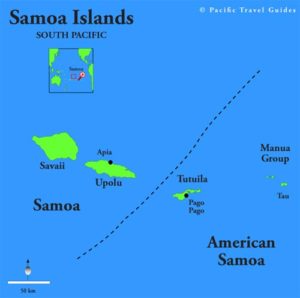 The dateline change means Samoan nationals no longer share the same day with their friends and families in American Samoa. But they can share Christmas dinner on two separate Christmas days! Because of that dateline draw, American Samoa is where a day officially ENDS, and Samoa where a day officially BEGINS.
The dateline change means Samoan nationals no longer share the same day with their friends and families in American Samoa. But they can share Christmas dinner on two separate Christmas days! Because of that dateline draw, American Samoa is where a day officially ENDS, and Samoa where a day officially BEGINS.
More about that in tomorrow’s post, when I would actually LOSE a day of my life!
» posted on Thursday, July 14th, 2022 by Linda Lou Burton
You Must Remember This
Originally Published July 17, 2020 by Linda Lou Burton posting about American Samoa from Little Rock, Arkansas – On June 23, 2012, I was at the Polynesian Cultural Center on the island of Oahu, Hawaii, with my granddaughter, who was 10. Here’s how it went:
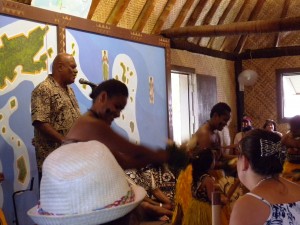 They found a place for Kayla and me on the back row of the jam-packed Fiji hut, and there we sat, bamboo sticks in hand, learning to chant and sing Fiji style. And, learning how to remember. The presentation at the Fiji settlement in the Polynesian Cultural Center was titled “History through Chants & Dance” and we’d just been taught how, as a group, to beat out rhythms, “one-two one-two-three” then “one-two-three-four” fast and slow, stop; then a call to us, “moo-oo” then our response “mai-ii” and repeat; somehow the roomful of us managed to do this together; and somehow, the feel of it began to stick in our memories.
They found a place for Kayla and me on the back row of the jam-packed Fiji hut, and there we sat, bamboo sticks in hand, learning to chant and sing Fiji style. And, learning how to remember. The presentation at the Fiji settlement in the Polynesian Cultural Center was titled “History through Chants & Dance” and we’d just been taught how, as a group, to beat out rhythms, “one-two one-two-three” then “one-two-three-four” fast and slow, stop; then a call to us, “moo-oo” then our response “mai-ii” and repeat; somehow the roomful of us managed to do this together; and somehow, the feel of it began to stick in our memories.
Our narrator explained the value of learning by chanting: “we had no written language until recent times, so stories and our history were passed down orally. Family is very important in our culture, and children are taught from the beginning about their ancestors,” he continued. “My 10-year old son can recite our family genealogy for 17 generations.”
Kayla and I exchanged glances, startled. Seventeen generations?
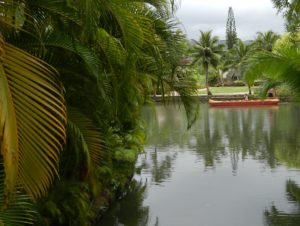 The Polynesian Cultural Center – rated the top tourist attraction in Hawaii, is a non-profit organization operated by the LDS church. It is a family place with pleasant walkways and waterways meandering through 42 acres of Polynesian “settlements” representing Samoa, New Zealand (Aotearoa-Maori), Fiji, Hawaii, Tahiti, Tonga, and Easter Island (Rapa Nui). Its purpose is simply to preserve the culture of Polynesia. It’s all about remembering.
The Polynesian Cultural Center – rated the top tourist attraction in Hawaii, is a non-profit organization operated by the LDS church. It is a family place with pleasant walkways and waterways meandering through 42 acres of Polynesian “settlements” representing Samoa, New Zealand (Aotearoa-Maori), Fiji, Hawaii, Tahiti, Tonga, and Easter Island (Rapa Nui). Its purpose is simply to preserve the culture of Polynesia. It’s all about remembering.
As I planned my 2020 RTW stops in Hawaii, American Samoa, and New Zealand, I thought back to that day, and how little I really know of Polynesian culture. I’d planned to remedy that somewhat today as I explored the National Park of American Samoa, which of course is closed due to COVID-19, but I’ll share some facts from their website, https://www.nps.gov/npsa
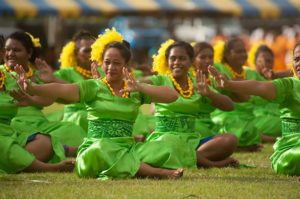 The Samoan culture is Polynesia’s oldest. We believe the first people of the Samoan Islands came by sea from southwest Asia some 3,000 years ago. Over the centuries, distinct cultural traits emerged that we now call fa’asamoa (fah-ah-SAH-mo-ah). From Samoa seafaring explorers and settlers journeyed to other Polynesian island groups hundreds of miles away.
The Samoan culture is Polynesia’s oldest. We believe the first people of the Samoan Islands came by sea from southwest Asia some 3,000 years ago. Over the centuries, distinct cultural traits emerged that we now call fa’asamoa (fah-ah-SAH-mo-ah). From Samoa seafaring explorers and settlers journeyed to other Polynesian island groups hundreds of miles away.
Follow the Fa’a Samoa —The Samoan Way
Alofa and Afio Mai! — Hello and Welcome — with some tips for pleasant visits to the villages of the islands.
- Always ask villagers for permission before taking photographs, using the beach, or engaging in other activities, however unobtrusive your actions may seem. Permission will almost certainly be granted.
- Sunday is the day for church, rest, and especially for quiet around the villages. Activities that are acceptable on other days, such as swimming, may not be permitted on Sunday.
- In a traditional home, called a fale (fah-LAY), sit down on the floor before talking, eating, or drinking. Cross your legs or pull a mat over them; it is impolite to stretch out your legs uncovered.
- Do not eat or drink while walking through a village.
- Each evening around dusk, villagers observe a time for prayers called Sā. If you are entering a village during Sā, stop and wait quietly until Sā ends. You may even be invited to join in a family prayer. It is not necessary to stop for Sā on the main roads.
- It is considered an honor to be asked to share ‘ava (a local drink made from the root of the pepper plant). To show respect, spill a few drops on the ground or mat in front of you, then raise your cup and say manuia (mahn-WE-ah) before drinking.
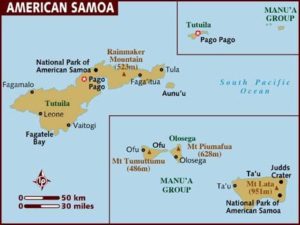 The ONLY US National Park south of the equator, the National Park of American Samoa’s 13,500 acres are distributed across three islands: Tutuila, Ofu, and Ta‘ū. Its purpose is to preserve and protect coral reefs, tropical rainforests, fruit bats, and most importantly, Samoan culture. Part of the US National Park System since October 31, 1988, it is unusual in that the NPS does not own the Park lands, but entered into a 50-year lease with Samoan village councils.
The ONLY US National Park south of the equator, the National Park of American Samoa’s 13,500 acres are distributed across three islands: Tutuila, Ofu, and Ta‘ū. Its purpose is to preserve and protect coral reefs, tropical rainforests, fruit bats, and most importantly, Samoan culture. Part of the US National Park System since October 31, 1988, it is unusual in that the NPS does not own the Park lands, but entered into a 50-year lease with Samoan village councils.
Twenty-nine states have national parks, as do the territories of the US Virgin Islands, and American Samoa. There are currently 62 parks in system, with this mission: “to preserve unimpaired the natural and cultural resources and values…for the enjoyment, education, and inspiration of this and future generations.”
It’s all about remembering.
Pass It Forward https://capitalcitiesusa.org/?p=2365
Want Me To Jump? https://capitalcitiesusa.org/?p=2383
» posted on Wednesday, July 13th, 2022 by Linda Lou Burton
A Pretending Day
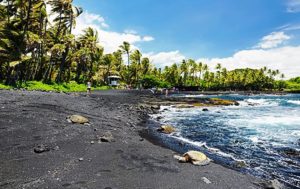 Originally Published July 16, 2020 by Linda Lou Burton posting about American Samoa from Little Rock, Arkansas – Let’s pretend. Pretend that I wake up this morning in Volcano House, after an entire day peering into volcanoes and wandering black-sand beaches on Hawaiian Time, meaning “no hurries, no worries, no schedules.” Pretend I have a leisurely breakfast, load up the Budget, and drive 42 miles to Hilo.
Originally Published July 16, 2020 by Linda Lou Burton posting about American Samoa from Little Rock, Arkansas – Let’s pretend. Pretend that I wake up this morning in Volcano House, after an entire day peering into volcanoes and wandering black-sand beaches on Hawaiian Time, meaning “no hurries, no worries, no schedules.” Pretend I have a leisurely breakfast, load up the Budget, and drive 42 miles to Hilo.
My Hawaiian Airlines flight 181 actually IS departing Hilo (ITO) at 10:10 AM and setting down in Honolulu (HNL) at 11. That’s what they notified me yesterday via email, as “inter-island travel” is now allowed by state mandate.
 But that’s just half my story. I planned to lounge around the airport, no rush, till time to board my flight to Pago Pago, American Samoa. Getting to American Samoa is no easy task – back in February when I began planning my RTW, I discovered there aren’t many flights in, or out. A few from Honolulu to AS, and even fewer from AS to New Zealand, my next destination.
But that’s just half my story. I planned to lounge around the airport, no rush, till time to board my flight to Pago Pago, American Samoa. Getting to American Samoa is no easy task – back in February when I began planning my RTW, I discovered there aren’t many flights in, or out. A few from Honolulu to AS, and even fewer from AS to New Zealand, my next destination.
So why go there?
Reason 1: National Park of American Samoa. After Haleakala NP and Hawaii Volcanoes NP, a stop at our most far-flung US National Park just made sense, especially since I’d already be flying that direction on my way to New Zealand and Australia. Tick off my 35th NP!
Reason 2: Pago Pago. I’ve never been to a single one of our US Territories, so a stayover in Pago Pago, capital of American Samoa, seemed the natural next step. A whole new line of capital cities!
Reason 3: Who wouldn’t want to go to a place called “Pago Pago”? How sweet is that?
First lesson about this delightful place, our only US capital south of the equator: please don’t pronounce it “PAY-go-PAY-go.” The letter “g” in Samoan sounds like “ng,” so the correct pronunciation is “PAHNG-oh-PAHNG-oh .” Got it?
American Samoa is 2,600 miles from Honolulu and 2,900 miles from Auckland, New Zealand, a collection of five tiny islands in the South Pacific Ocean with a total land area of 76.8 square miles. (That’s just a wee bit larger than Washington, DC.) It is home to around 55,000 people, and of that, 89% are Samoan. Most American Samoans are bilingual and speak English and Samoan fluently.
I won’t get into a history lesson about HOW American Samoa came to be “American” and a US Territory, but here are a few things the tourism folks want you to know:
Rainforest-covered tropical islands. Emerald jewels in a vast blue expanse of ocean. An eco-tourism paradise. Eastern arm of the Samoan archipelago. Home to Polynesians proud of their strong Samoan culture and heritage. The friendliest people in the South Pacific.
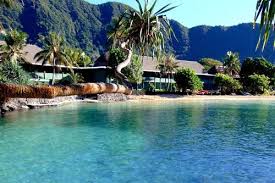 I’m sold, right there, even without the draw of another national park and capital city. My reservation for tonight was at Sadie’s-By-The-Sea, right on the beach. Tomorrow I’ll tell more about this island paradise, and the park, where I intended to spend the day relaxing, and exploring, in equal measure.
I’m sold, right there, even without the draw of another national park and capital city. My reservation for tonight was at Sadie’s-By-The-Sea, right on the beach. Tomorrow I’ll tell more about this island paradise, and the park, where I intended to spend the day relaxing, and exploring, in equal measure.
As it is, COVID-19 intervened. Of the 56 US states and territories reporting to the CDC, American Samoa, week after week since this began, has stayed at 0. Zero. No cases. The only place. Perhaps its isolation had a hand in that.
A restriction was put in place in March that US Citizens coming to American Samoa had to quarantine 14 days in Hawaii, but that apparently has been lifted. My Hawaiian Airlines flight 465 from Honolulu (HNL) to Pago Pago (PPG) will depart at 4:35 and arrive at 9:20 tonight, according to yesterday’s email. Maybe it is filled with people who live in Hawaii? Or passed the quarantine test? Or some other test? I don’t know.
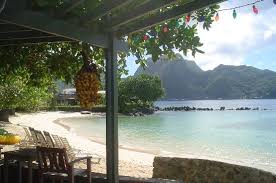 I tried to call Sadie’s-By-The-Sea today. Their website is down, and no one answered the phone. I should be sleeping in Pago Pago tonight, listening to those Pacific waters lapping gently against the shore, right outside my door.
I tried to call Sadie’s-By-The-Sea today. Their website is down, and no one answered the phone. I should be sleeping in Pago Pago tonight, listening to those Pacific waters lapping gently against the shore, right outside my door.
Let’s pretend I am.
» posted on Tuesday, July 12th, 2022 by Linda Lou Burton
The Hot Spot
 Originally Published July 15, 2020 by Linda Lou Burton posting about Hawaii Volcanoes from Little Rock, Arkansas – Some folks go to Hawaii to sit on the beach and drink Mai Tai’s, peering at the ocean over a slab of pineapple on the rim of their glass. Peering over the rim of a volcano is what I’m interested in, and it is the main attraction at Volcano House on the big island of Hawaii. The “only volcano hotel in Hawaii,” at 1 Crater Rim Drive in Hawaii Volcanoes National Park, Volcano House is a historic retreat right by the rim. “Breathtaking” is the word as you gaze over the Kilauea
Originally Published July 15, 2020 by Linda Lou Burton posting about Hawaii Volcanoes from Little Rock, Arkansas – Some folks go to Hawaii to sit on the beach and drink Mai Tai’s, peering at the ocean over a slab of pineapple on the rim of their glass. Peering over the rim of a volcano is what I’m interested in, and it is the main attraction at Volcano House on the big island of Hawaii. The “only volcano hotel in Hawaii,” at 1 Crater Rim Drive in Hawaii Volcanoes National Park, Volcano House is a historic retreat right by the rim. “Breathtaking” is the word as you gaze over the Kilauea  caldera from your room. From your room! You are on the edge of an active volcano and a UNESCO Heritage Site, 4,000 feet above sea level.
caldera from your room. From your room! You are on the edge of an active volcano and a UNESCO Heritage Site, 4,000 feet above sea level.
I wake up this morning in my king-size bed (on my “vacation that would have been if not for a world crisis”) and watch as wisps of smoke curl over the barren landscape. An ever-evolving landscape, shaped by volcanic activity, always a ticking clock.
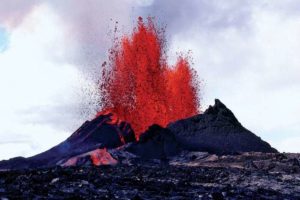 Volcanoes are the “fast-forward” of geological construction. Winds and waters eroded out the Grand Canyon over eons, ice-age glaciers took a while to scrape out the Great Lakes. But volcanoes do their bit in a hurry. Blam! Ash goes flying, hot lava flows, and anything in the pathway is toast. Result: new land is formed, old land is reshaped.
Volcanoes are the “fast-forward” of geological construction. Winds and waters eroded out the Grand Canyon over eons, ice-age glaciers took a while to scrape out the Great Lakes. But volcanoes do their bit in a hurry. Blam! Ash goes flying, hot lava flows, and anything in the pathway is toast. Result: new land is formed, old land is reshaped.
Do you know about The Hot Spot? That’s the baby-maker of the Hawaiian island chain, and it continues to build islands. The tectonic plate beneath much of the Pacific Ocean keeps moving northwest, but the “hot spot” remains stationary, creating new volcanoes. Currently active volcanoes are on the southern half of Hawaii island; the newest, Lōʻihi Seamount, is located south of the coast.
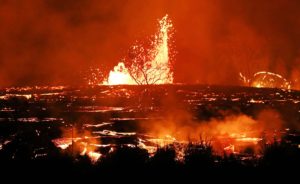 Haleakalā, on Maui, erupted sometime in the 18th century, possibly earlier. Kīlauea exploded in 1790, the deadliest eruption known to have occurred in what is now the United States. It erupted again in May 2018, opening 22 fissure vents on its East Rift Zone. The destruction, coupled with lava flows and sulfur dioxide fumes, necessitated the evacuation of more than 2,000 people.
Haleakalā, on Maui, erupted sometime in the 18th century, possibly earlier. Kīlauea exploded in 1790, the deadliest eruption known to have occurred in what is now the United States. It erupted again in May 2018, opening 22 fissure vents on its East Rift Zone. The destruction, coupled with lava flows and sulfur dioxide fumes, necessitated the evacuation of more than 2,000 people.
It’s quiet today. Sensors and video cams keep track of every gurgle and tremor, you betcha. Mauna Loa, about 20 miles northwest of Kilauea and the largest active volcano on earth, last erupted in 1984. For a virtual visit, check out a few live cams, courtesy of the USGS Hawaiian Volcano Observatory.
https://www.nps.gov/havo/learn/photosmultimedia/webcams.htm
- Kīlauea Caldera from HVO Observation Tower is a live panorama of Kīlauea Caldera.
- Halemaʻumaʻu, water lake, gives a live panorama from the west rim of the new summit collapse features; Thermal image of Halemaʻumaʻu and water lake is a live thermal image.
- Mokuʻāweoweo Caldera from the Northwest Rim, positioned on the rim of Mauna Loa volcano, is a temporary research camera. If you look carefully around early morning or late evening, you may see a few thermal areas emitting steam.
- Mokuʻāweoweo Caldera Thermal is a temporary thermal camera there; the temperature scale is in degrees Celsius up to a maximum of 500 degrees (932 degrees Fahrenheit).
Volcanoes are hot!
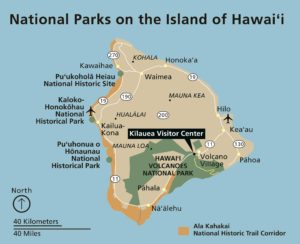 But there are also plenty of cool things within the 4,028 square miles that make up the Big Island of Hawaii. Trails through rainforest lead to hide-away waterfalls; black-sand beaches are the place to catch a sea turtle napping. Devastation Trail winds through exotic flora and fauna and now-cooled lava flows. Imagine yourself walking through a 35-foot-high lava tube! The highest point on the island is Mauna Kea. At 13,796 fee it is (just barely) 125 feet higher than Mauna Loa. The lowest point in Hawaii is at water’s edge – the Pacific Ocean.
But there are also plenty of cool things within the 4,028 square miles that make up the Big Island of Hawaii. Trails through rainforest lead to hide-away waterfalls; black-sand beaches are the place to catch a sea turtle napping. Devastation Trail winds through exotic flora and fauna and now-cooled lava flows. Imagine yourself walking through a 35-foot-high lava tube! The highest point on the island is Mauna Kea. At 13,796 fee it is (just barely) 125 feet higher than Mauna Loa. The lowest point in Hawaii is at water’s edge – the Pacific Ocean.
Where you can sit on the beach and drink Mai Tai’s, with a nibble of pineapple, if you please.
Hawaii Volcanoes National Park https://www.nps.gov/havo/index.htm
Volcano House https://www.hawaiivolcanohouse.com/
